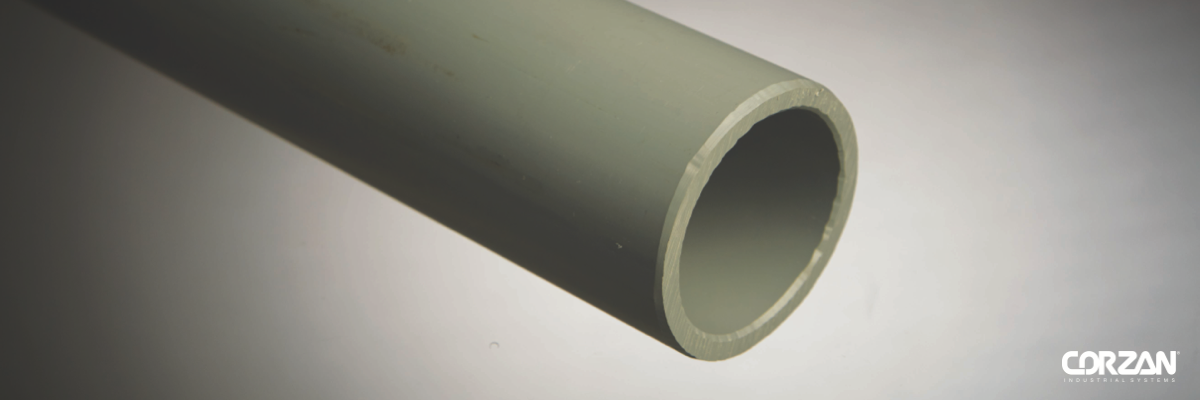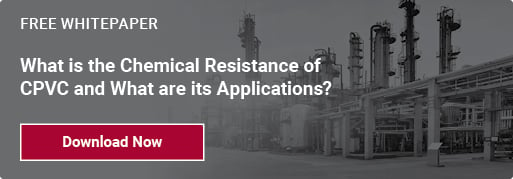CPVC Chemical Resistance to Caustic Soda (Sodium Hydroxide)
Sodium hydroxide, commonly known as caustic soda, is one of the most common industrial chemicals. A versatile alkaline, caustic soda is highly reactive and effective at breaking down certain compounds.
Common caustic soda applications include the:
- Pulp and paper industry for pulping and bleaching processes.
- Wastewater treatment industry for pH neutralization and wet-air scrubbers.
- Food and beverage industry as a cleaning agent.
- Personal care industry, such as soap making.
- Power generation industry for regenerating ion demineralization resin beds.
- Semiconductor industry for etching, plating acid neutralization and cleaning.
- Aluminum processing applications for dissolving compounds and extracting impurities.
For processing and storage of caustic soda, metals—such as stainless steel or carbon steel—or thermoplastics—such as polyethylene, polypropylene, PVC, and CPVC—are often used. But the corrosive nature of caustic soda, especially at elevated temperatures and concentrations, can shorten the life of any industrial system. With proper pipe and tank material selection, industrial applications can prolong their useful life.
Corrosion Concerns for Caustic Soda
In general, a material isn’t completely resistant or not to a chemical. Instead, corrosion resistance is more of a range. As system and environmental conditions are altered, the potential for corrosion changes.
When sodium hydroxide attacks CPVC—whether as a result of the caustic’s temperature or concentration, the pressure of the system, its length of use, or a combination of those factors—it occurs through two primary mechanisms:
- General Degradation. When the CPVC resin or compounding ingredients in the material are altered or destroyed by a chemical, general degradation has occurred. This degradation is often characterized by discoloration and blistering of the pipe, sheet, or liner surface.
- Localized Stress Corrosion Cracking. Similar to how stress corrosion works in metals, localized stress in a CPVC material can enhance the effects of chemical attack and encourage crack propagation from the area under stress.
The degree at which degradation and corrosion occur from sodium hydroxide depends on both the solution’s concentration and temperature and the CPVC’s formulation and component manufacturing quality.
Caustic Soda Chemical Concentration and Temperature
As the concentration and temperature of a caustic soda solution increases, the rate of attack on the thermoplastic material increases.
To test corrosion resistance, a sample of CPVC material is immersed in a caustic solution with some stress applied, and held at a constant temperature for 90 days.
After that period, the specimen’s surface is observed for possible changes in texture, discoloration, swelling, clouding, tackiness, bubbling or cracking—each signify chemical attack. The sample is also measured for potential weight loss, which is a sign of general degradation.
In a lab test, Corzan® CPVC showed good resistance against sodium hydroxide up to 50% concentration at 180°F (82°C). Above that concentration and temperature, signs of stress corrosion cracking and general degradation developed.
CPVC Formulations and Processing Quality
Due to the unique corrosive nature of caustic soda, the laboratory test only confirms resistance to caustic soda for Corzan CPVC, not generic or other known brands of CPVC.
Resistance to sodium hydroxide is heavily dependent on the CPVC formulations and the manufacturer’s processing quality and consistency.
CPVC Formulations
Not all CPVC compound is created equal. Inherent molecular qualities of the material differ, altering the final product’s performance.
The importance of CPVC’s chlorine content: What gives CPVC its increased temperature, pressure and flame resistance—in comparison to PVC—are the additional chlorine atoms that protect the carbon backbone of its molecular chain. Though most CPVC resins contain 63 to 69% chlorine, some formulations increase this up to 74%. Additional chlorine content correlates with better resistance to higher temperatures and pressures.
The inclusion of CPVC additives: CPVC resin is often infused with additives to enhance many of the resin’s inherent properties, and notably eases processability. When additives are not included to ease processability, corrosion resistance of the final product may be harder to achieve during processing.
Better quality resin with higher quality additives in the process leads to higher performance against degradation.
CPVC Manufacturer Processing
After the CPVC compound is passed off to the manufacturer, it is their job to turn it into a usable geometry that achieves maximum chemical resistance.
Processing must first melt the compound. The resulting melt must then be injected into a fitting mold or pushed through a pipe die to form the final part geometry. Proper processing ensures the areas where the melt comes together in the mold, or after exiting the die, properly fuse together. If care isn’t taken to achieve proper fusion, these areas become susceptible to chemical attack.
Know your manufacturers. Variations in the pressure, temperature, concentration, installation and maintenance of the CPVC material can affect the life expectancy of a system. The full hydrostatic pressure rating of the pipe may not apply to the entire range of temperature and concentration designated.
Learn More About Using Corzan® CPVC
Contact Corzan Industrial Systems or view a list of our partner manufacturers to see who’s processed materials we trust to resist caustic soda corrosion and continue our high quality standards during processing.
Or, view the Corzan CPVC Chemical Resistance table, which analyzes Corzan CPVC's resistance to more than 400 chemicals and compounds.


